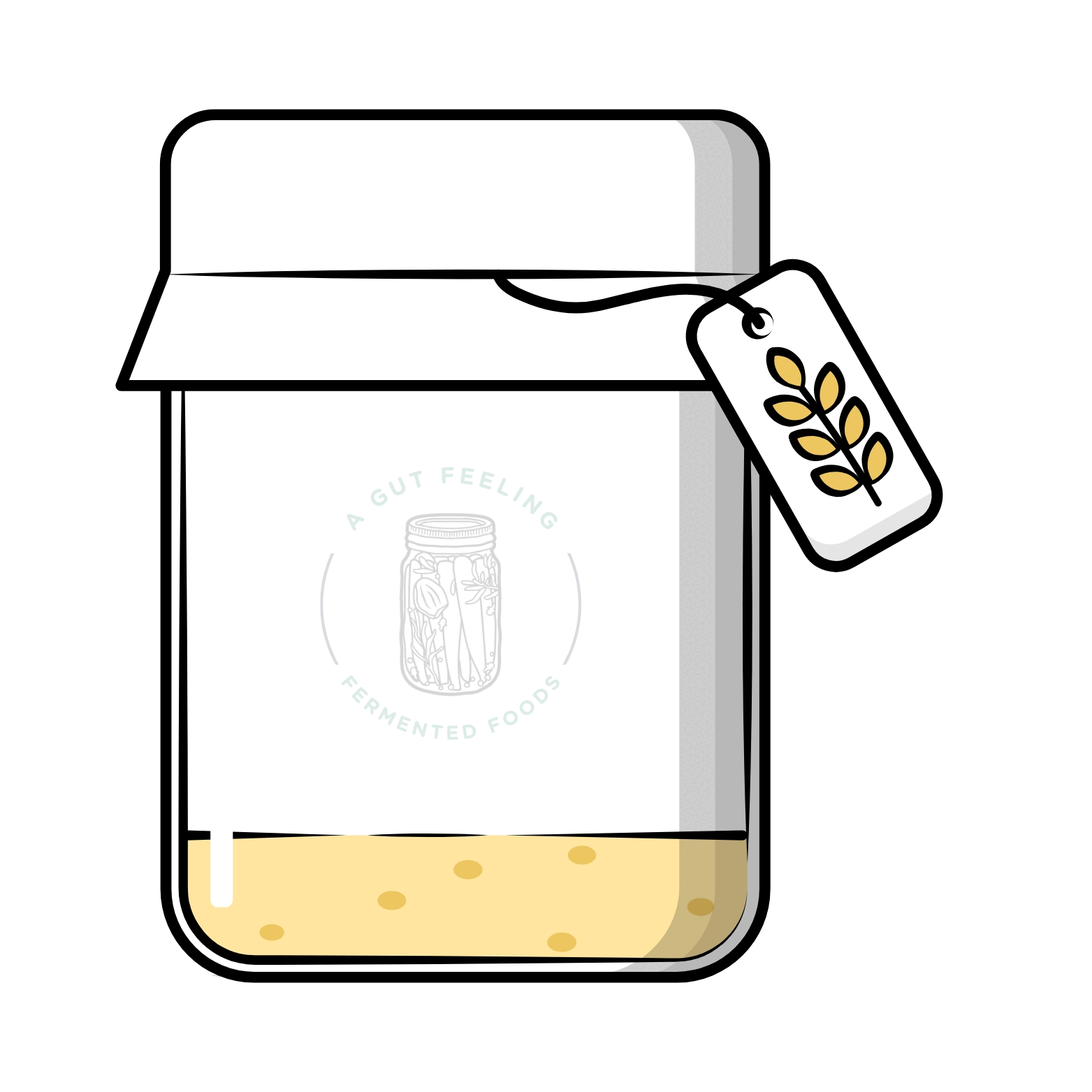How to Care for a Fresh Milled Sourdough Starter
The A Gut Feeling Guide to Lifelong Fermentation by Natalie Clark
Whether you’re just starting your sourdough journey or switching from all purpose dead flour to fresh milled whole grains, this guide will walk you through everything you need to know to nurture a lively, reliable, sourdough starter. One that’s rich in wild yeast, loaded with flavor, and alive with microbial activity.
What is a Sourdough Starter ?
A sourdough starter is a living culture, a symbiotic colony of wild yeasts and lactic acid bacteria (LAB). You cultivate these by feeding whole grain flour and water. Over time, this dynamic ecosystem ferments the flour, producing the acids, enzymes, gases, and organic compounds that make sourdough not only delicious but deeply digestible.
Why Fresh-Milled Starters Are Different
Fresh milled flour is the whole grain. The bran, germ, and endosperm ground and used immediately. This vibrant flour is full of enzymes, natural oils, and wild microorganisms. But its freshness also means:
It ferments faster
It requires slightly more water
It creates a more diverse and resilient microbial culture
This makes fresh milled sourdough more nutrient dense, richer in flavor, and easier to digest, but also requires slightly different care than store bought flours.
What Causes the Bubbles and Rise?
When you feed your starter with fresh milled flour and filtered water, you’re activating a biological chain reaction involving:
1. Wild Yeasts (e.g., Saccharomyces cerevisiae, Candida milleri)
These fungi feed on the simple sugars (glucose, maltose, fructose) released from the flour as enzymes break down starch.
As they metabolize sugars, they produce carbon dioxide (CO₂) gas.
CO₂ becomes trapped in the matrix of gluten and water, causing your starter to rise and form visible bubbles.
Key Reaction:
Fermentation of glucose by yeast
→ C₆H₁₂O₆ → 2 C₂H₅OH (ethanol) + 2 CO₂
2. Lactic Acid Bacteria (LAB) especially Lactobacillus plantarum, L. brevis, and Leuconostoc species
These beneficial bacteria consume different sugars (some metabolize maltose, some glucose) and produce lactic acid and acetic acid.
LAB are anaerobic, meaning they thrive in low oxygen environments.
They acidify the starter to a pH of around 3.8–4.2, creating an environment that suppresses harmful microbes and promotes yeast symbiosis.
Key Reaction:
Heterofermentative LAB:
→ Glucose → Lactic acid + Acetic acid + CO₂ + Ethanol
3. Enzymes: Amylase, Protease, Phytase
Fresh milled flour contains active enzymes that are lost in shelf-stable flours. These enzymes support fermentation by breaking down complex compounds into simpler ones.
Amylase converts starch into sugars that feed yeast and LAB.
Protease breaks down gluten bonds, softening the texture and improving extensibility.
Phytase degrades phytic acid, an anti-nutrient, unlocking minerals for absorption.
4. The Gluten Network: Why It Rises and Then Falls
The stretch and rise you see in a starter is due to gluten proteins (gliadin + glutenin) forming an elastic matrix that captures CO₂ gas.
As gas builds, the network stretches and the starter rises in the jar.
Eventually, the starch and protein are used up or the acids weaken the matrix.
The starter deflates, a natural sign it’s time to feed again.
Why Fresh Milled Flour Ferments Faster
Fresh milled flour is:
Enzyme rich – boosting sugar availability for microbes
Microbe rich – carrying its own ambient wild yeast and bacteria
Full of oxygen – freshly milled flour supports aerobic fermentation
Less oxidized – the bran and germ haven’t gone rancid or denatured
All of this means fermentation starts earlier, peaks faster, and produces more flavor complexity. You may notice sour notes, nutty aromas, and deeper caramelization in your bread.
Supplies You Will Need To Nurture Your Sourdough Starter
A Weck glass jar is my favorite for storing sourdough! The jar is easy to clean, and you don’t have to worry about rust because of the glass lid. The clasps keep the jar non airtight, perfect for sourdough while still maintaining a sanitary environment.
A digital kitchen scale (grams are more precise!)
Wooden spoon or silicone spatula
Filtered or dechlorinated water
A Danish hook whisk is ideal for thoroughly incorporating flour into your sourdough starter during feeding, as well as for evenly mixing in the hooch.
How to Reactivate a Refrigerated Sourdough Starter:Your Step-by-Step Guide to Waking Up Dormant Microbial Magic
Has your starter been napping in the fridge for a while? Whether it’s been 2 weeks or 2 months, you can bring it back to life. This guide will walk you through exactly how to revive a cold, sluggish starter, especially one made from fresh-milled whole grains like spelt, kamut, einkorn, or wheat.
What Happens to a Starter in the Fridge?
In cold storage, wild yeast and beneficial bacteria enter a dormant state. Microbial activity slows way down, and:
Acids accumulate, especially acetic acid (vinegar smelling)
A layer of alcohol may form on top (“hooch”)this is normal
Gluten structures begin breaking down
Beneficial populations may become unbalanced if left too long
But with warmth, food, and time, the good microbes bounce back beautifully.
What You’ll NeedYour cold starter (even if it smells strong!)
Fresh milled flour
Filtered, dechlorinated water
A clean glass jar
A rubber band (to mark rise)
A digital kitchen scale (for best results)
Step-by-Step: Reviving Your Starter
Step 1: Assess the Situation
Take your starter out of the fridge and remove the lid.
Smell: Strong, vinegary, or cheesy is okay. Mold (fuzzy black, pink, or orange) is not if you see it, toss and start over.
Hooch on top? You can pour it off or stir it in. It’s alcohol from fermentation, not harmful.
Texture: It may be thin, separated, or grayish. That’s normal.
Step 2: First Feeding (Dilute & Refresh)
Discard all but 20g of your starter
Feed it with:
40g fresh-milled flour
40g room temperature filtered water
Mix thoroughly. Place in a clean jar and cover loosely (not airtight). Let it rest at room temperature for 12–24 hours.
Step 3: Observe, Then Repeat Feedings
After 12–24 hours, check for signs of life:
Bubbles forming
Tangy smell
Slight rise
If you see any of the above, discard (put in another jar to use for recipes that don’t use yeast a ““discard” recipe. Muffins, crackers,pizza crust) all but 20g and repeat the feeding:
Feed Ratio: 1 part starter : 2 parts flour : 2 parts water
(e.g. 20g starter + 40g flour + 40g water)
Repeat this every 12–24 hours for 3–5 days.
Step 4: Increase Feed Ratio as It Strengthens
Once the starter starts to double in 4–6 hours after feeding:
Switch to 1:3:3 or even 1:5:5 (more food for the hungry microbes!)
Example:
20g starter + 60g flour + 60g water (1:3:3)
You can now resume to your regular feeding schedule
Troubleshooting Slow or Stubborn Starters
Quick Recap
Yeast (Saccharomyces, Candida) produce CO₂ to make it rise
LAB (Lactobacillus) produce lactic + acetic acids for preservation
Cold temps slow yeast more than LAB → leads to sourer starter
Regular feedings re-balance the microbial ratios and dilute excess acid
Fresh-milled flour reactivates fermentation faster due to living enzymes
When Is It Ready?
Your starter is mature and ready for baking when:
•It doubles in size within 4–6 hours of feeding (fresh milled flour starters rise and fall quicker then dead flour)
• It has a web of bubbles throughout the jar
• It smells like tangy yogurt, apples, or a hint of vinegar (smells fermented)
This usually happens by Day 7–10 (with a sourdough starter that you are newly using, or are reactivating after it has been stored in the refrigerator for an extended period of time), but with fresh-milled flour, it may happen sooner.
Ongoing Care: Keeping Your Starter Alive
Option A:
Refrigerator Maintenance (Low Commitment)
Perfect if you bake once a week or less.
Weekly Feeding Routine:
Remove from fridge and let it come to room temp (2 hours)
Discard all but 60g starter
Feed with 60g flour + 60g water
Let it ferment at room temp for 4 hours
Return to fridge loosely covered
Option B:
Countertop Maintenance (High-Use Bakers)
Feed your starter every 24 hours (or every 12 if your home is warm).
Daily routine:
Discard all but 60g starter
Feed 60g flour + 60g water
Let ferment at room temp and use as needed
Feeding Ratios (Adjust for Your Needs)
Basic ratio: 1:1:1 (starter:flour:water by weight)
Need more for a recipe? Try:
25g starter + 50g flour + 50g water (1:2:2)
20g starter + 100g flour + 100g water (1:5:5, for slower ferments)
The more you dilute the starter, the slower the fermentation this is great for hot climates or longer prep windows.
Hydration Tips for Fresh-Milled Flour
Whole grain flour absorbs more water than white flour.
Aim for a thick pancake batter texture.
You may need to increase water by 5–10% depending on your grain (especially kamut, spelt, or einkorn).
Why This Starter Is Good for Your Gut
Fresh-milled flour starters are teeming with wild yeast and lactic acid bacteria (LAB). These microbes:
Pre-digest phytic acid and anti-nutrients in grain
Create lactic and acetic acids that protect against pathogens
Improve mineral absorption (zinc, iron, magnesium)
Make gluten easier to tolerate for many people
In short:
they break down what your body would struggle with a symbiotic act of nourishment and healing.

